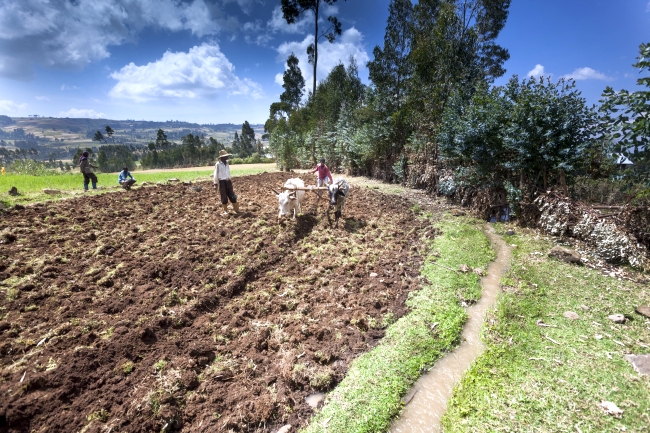Why some farmers adopt rainwater management technologies, whilst others ignore them…
Rural Ethiopia is a tough place to make a living. Resources are few. The landscape can be steep and unforgiving. Transport connections are scant. Nevertheless, there is huge potential for productive agriculture. Good soils and a clement climate auger well, but reliable water supplies are a headache. There is not necessarily any absolute water scarcity, but rainfall distribution is extremely uneven and highly seasonal. Drought frequently results in crop failure, while high rainfall intensities lead to low infiltration and high runoff causing soil erosion and land degradation. Prolonged dry periods hinder multiple cropping, and contribute to low agricultural productivity and high levels of food insecurity.

Photo: Petterik Wiggers/Panos Pictures UK
Over decades of experimentation with a range of soil and water conservation measures, often drawing on local knowledge, professional agriculturalists have developed several basic technologies that can improve rainwater management. Bunds or hillside terraces, for instance, can help retain water, allowing it to percolate into the subsoil. This opens up opportunities for digging wells or establishing orchards. Planting trees and enclosing livestock reduces erosion. Diverting local rivers can create possibilities for irrigation.
Reluctance to adopt
It all seems very straightforward: by adopting some simple and relatively cheap landscape management techniques, farmers could both boost their yields and help preserve the landscape they depend on.
Yet, many farmers in the Blue Nile River Basin don’t adopt rainwater management technologies.
A team of researchers, led by the International Water Management Institute (IWMI), decided to find out why.
They undertook a survey of over 650 farm households in the Blue Nile River Basin. The results of their research have just been published in a new IWMI Research Report, Determinants of adoption of rainwater management technologies among farm households in the Nile River Basin.
Part of a package
“There is no single reason why some farmers are more likely to adopt new practices than others,” says Gebrehaweria Gebregziabher, a research economist based at IWMI’s East Africa and Nile Basin Office in Addis Ababa. “Social background, community or family support and the likelihood that investments will yield a good return all play a role.”
The survey does reveal, however, that technological adoption should not be looked at in isolation.
“There is a strong correlation between the adoption of specific rainwater management (RWM) technologies, with the adoption of another technology alongside it,” says Gebregziabher.[pullquote type=”pullquote1″ content=”This suggests that, not only is it important to consider the socioeconomic and demographic characteristics of households, but also that technologies should be marketed to farmers as part of a package.” quote_icon=”yes” align=”center”]This suggests that, not only is it important to consider the socioeconomic and demographic characteristics of households, but also that technologies should be marketed to farmers as part of a package.[/pullquote]
This represents something of a departure from previous approaches, when attempts were made to introduce single innovations in isolation. A more holistic approach would be far more likely to encourage uptake.
[hr top=”yes”/]
Gebregziabher, G.; Rebelo, L-M.; Notenbaert, A.; Ergano, K.; Abebe, Y. 2013. Determinants of adoption of rainwater management technologies among farm households in the Nile River Basin. Colombo, Sri Lanka: International Water Management Institute (IWMI). 34p. (IWMI Research Report 154). doi: 10.5337/2013.218

